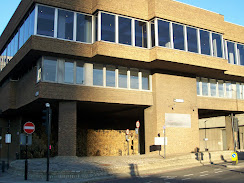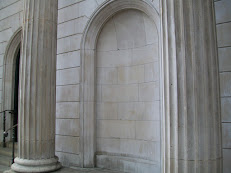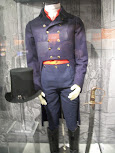It was time for to visit the London sites of another of my favourite stories, ‘The Man With The Twisted Lip’ (with a couple of detours). I had made a limited attempt during a previous sojourn, but had improved information and wished to visit the sites in order. However, on reaching Tower Hill Underground Station, my first destination was Lime Street, a minor road in the city of London between Fenchurch Street and Leadenhall Street. In ‘The Mazarin Stone’, Count Sylvius instructed Sam Merton to take the stolen stone to one of his contacts Van Seddar in Lime Street, who would then take the stone to Amsterdam where it would be cut into four pieces thus hiding its identity. There were no Jewellers in Lime Street itself, but I found the location of Van Seddar’s former jewellers in the adjoining Leadenhall Market, now called ‘Beau Gems’.
”'I thought Van Seddar was going next week' - Sam Merton
'He was. But now he must get off by the next boat. One or other of us must slip round with the stone to Lime Street and tell him' - Count Sylvius
'But the false bottom ain't ready' - Merton
'Well, he must take it as it is and chance it. There's not a moment to lose'" - Sylvius [MAZA]
On the other side of the market was The Glass House, in the evocatively named Bulls Head Passage. This appeared as the entrance to ‘The Leaky Cauldron’ in ‘Harry Potter and the Philosopher’s Stone’.
From here a ten minute walk brought me to my first ‘Twisted’ location, Cannon Street Station, into which the missing Neville St. Clair travelled every day from his home at Lee, returning home on the 5.14pm train.
“[Neville St. Clair] had no occupation, but was interested in several companies and went into town as a rule in the morning, returning by the 5:14 from Cannon Street every night” – Sherlock Holmes [TWIS]
A five minute walk brought me to Upper Thames Street and a location previously visited by myself as a possible location for ‘The Bar of Gold’, the Opium Den on Upper Swandam Lane in which Neville St. Clair was last seen alive, and where Watson found a disguised Holmes.
A further five minute walk brought me to Stew Lane, a much better fit for Upper Swandam Lane.
At the end of Stew Lane, I reached the Samuel Pepys Public House, a perfect fit for ‘The Bar of Gold’, backing onto the River Thames, and part of a 19th Century former Thameside tea warehouse.
_3%20%5BTWIS%5D.JPG)
_2%20%5BTWIS%5D.JPG)
“By the light of a flickering oil-lamp above the door I found the latch and made my way into a long, low room, thick and heavy with the brown opium smoke, and terraced with wooden berths, like the forecastle of an emigrant ship. Through the gloom one could dimly catch a glimpse of bodies lying in strange fantastic poses, bowed shoulders, bent knees, heads thrown back, and chins pointing upward, with here and there a dark, lack-lustre eye turned upon the newcomer” - Watson [TWIS]
Walking around the building, I found myself on Paul’s Walk, next to Paul’s Wharf. It was here that the trapdoor from ‘The Bar of Gold’ opened onto. Through here dead bodies were dumped into the Thames. ‘Hugh Boone’ also threw Neville St. Clair’s clothes (weighted down with coins) into this part of the Thames.
“They found upon the mud-bank what they had feared to find. It was Neville St. Clair’s coat, and not Neville St. Clair, which lay uncovered as the tide receded…..Every pocket stuffed with pennies and half-pennies–421 pennies and 270 half-pennies. It was no wonder that it had not been swept away by the tide” – Sherlock Holmes [TWIS]
It was then time for a second detour, this time to the nearby St. Paul’s Cathedral, where joining a free tour commemorating the 300th anniversary of Sir Christopher Wren’s death, I managed to gain access to the cathedral’s Geometric Staircase, which I had been unable to get to on a previous sojourn. It was down this staircase that Holmes and Watson dashed, making their way to the crypt (filmed at the nearby St. Bartholomew The Great) to stop Lord Blackwood’s ritual in ‘Sherlock Holmes’ (2009).

Having learnt a lot about Christopher Wren, I then made my way to my next ‘Twisted’ location, Threadneedle Street. The titular beggar’s begging spot was in a small alcove on the side of the Bank of England.
“Some little distance down Threadneedle Street, upon the left-hand side, there is, as you may have remarked, a small angle in the wall. Here it is that [Hugh Boone] takes his daily seat, cross-legged, with his tiny stock of matches on his lap, and as he is a piteous spectacle a small rain of charity descends into the greasy leather cap which lies upon the pavement beside him” – Sherlock Holmes [TWIS]
I then made my way around the corner into Bartholomew Lane, and the Bank of England Museum. At the heart of the museum was a recreation of what the inside of the Bank of England would have looked like 200 years ago. Other exhibits included an 1890 banknote which had been fraudulently amended from £5 to £50, and a display about Kenneth Grahame (author of ‘The Wind in the Willows’) who worked in the Bank.


Returning to Bank Station, I caught the Central Line to Tottenham Court Road, making my way along Endell Street, where Holmes and Watson walked on their way to Covent Garden Market to find ‘Breckinridge’, the original seller of Henry’s Baker’s stolen goose, in ‘The Blue Carbuncle’.
“We passed across Holborn, down Endell Street, and so through a zigzag of slums to Covent Garden Market” [BLUE]
Taking a slight left, and opposite the Royal Opera House (which features in both ‘The Red Circle’ and ‘The Hound of the Baskervilles’), I found myself at the Bow Street Police Museum. The Museum tells the story of the early Bow Street Patrols and Runners, London’s first official law enforcement service, and the Metropolitan Police officers who walked the streets of Covent Garden in their footsteps. It features the original Dock 2 from the attached Magistrates’ Court, a Bow Street Runners uniform, and other ephemera.
However, in terms of canonical connections, it also includes the cells where ‘the twist’ in ‘The Man With the Twisted Lip’ occurs.
“We both put our eyes to the grating. The prisoner lay with his face towards us, in a very deep sleep, breathing slowly and heavily…He was, as the inspector had said, extremely dirty, but the grime which covered his face could not conceal its repulsive ugliness….
‘He’s a beauty, isn’t he ?’ said the inspector.
‘He certainly needs a wash,’ remarked Holmes. ‘I had an idea that he might, and I took the liberty of bringing the tools with me’. He opened the Gladstone bag as he spoke, and took out, to my astonishment, a very large bath-sponge.
[Bradstreet] slipped his key into the lock, and we all very quietly entered the cell……’” [TWIS]
Bow Street Police Station opened on this site (28 Bow Street) in 1881, and was the only central London police station to have white lights outside rather than blue. The reason for this is unknown, but one rumour is that Queen Victoria did not approve of the blue lights when she went to the Royal Opera House opposite. Another rumour is that she disliked the colour as her beloved Albert died in a blue room at Windsor Castle. However, research has shown that the Queen rarely went out after Albert’s death in 1861, the same year that blue lights were introduced elsewhere, and did not visit the Royal Opera House for nearly another thirty years. So, this remains a mystery.
The station finally closed in 1992 (after 111 years) due to the Victorian wiring not being up to the new electronic police systems. Officers were redeployed to Charing Cross Police Station, on the site of the former Charing Cross Hospital, visited during a previous sojourn.
The Police Station filled the right of the building, with Bow Street Magistrates’ Court (now a meetings venue) filling the left. The Court featured a number of well-known cases including the first appearance of Oscar Wilde for indecency in 1895, Dr. Crippen in 1910, and the Kray Twins in 1969. The Court closed in 2006, with the work moving to Horseferry Road Magistrates’ Court (well known to me in a professional capacity).
Having wandered all the way round, and bought a few items from the gift shop, it was then time to catch a bus to Waterloo Station, and my train home.



_1%20%5BTPS%5D.JPG)
_2%20%5BTPS%5D.JPG)



_Lane'%20%5BTWIS%5D.JPG)
_1%20%5BTWIS%5D.JPG)
_4%20%5BTWIS%5D.JPG)














No comments:
Post a Comment